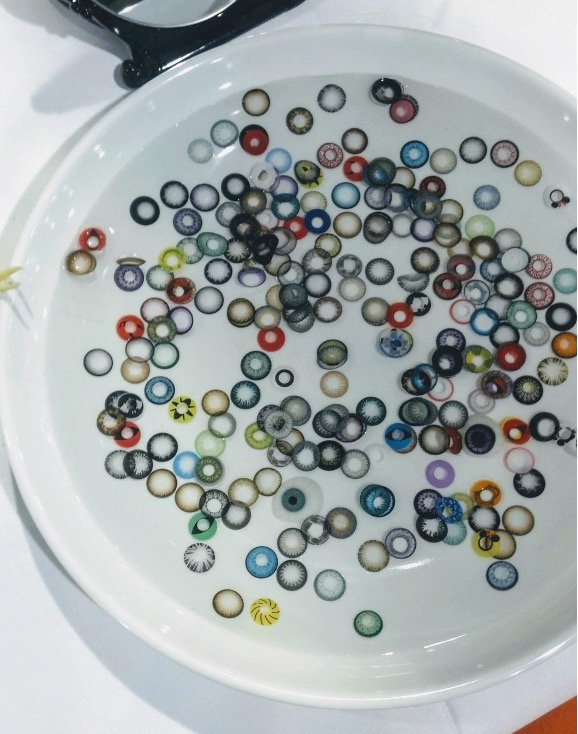 |
Q: Tattoos can interfere with MRI, as studies report cases of local tissue irritation and burns. Since cosmetic and prosthetic contact lenses can share some of the same chemicals used in tattoo ink, are they safe to wear during an MRI?
A: “It is safe to wear most contact lenses for an MRI, but cosmetic and prosthetic contact lenses are a potential exception; these lenses usually contain metallic oxides,” says Brian Chou, OD, of ReVision Optometry in San Diego. He notes that while metallic oxides are inorganic salts without ferromagnetic activity, associated impurities such as metallic fragments can interact with MRIs.
Adverse Effects
A 2013 case report out of Japan described a 28-year-old woman wearing “circle” cosmetic contact lenses who underwent a head MRI.1 Imaging showed a magnetic susceptibility artifact, or loss of signal or distortions. The patient did not experience discomfort, pain or heat during the imaging. The authors subsequently ran an in vitro MRI with “circle” contact lenses on a gelatin phantom. They confirmed the susceptibility artifact and measured a 1°C rise in temperature of the lens.
 |
|
Cosmetic contact lenses contain metallic oxides that can negatively affect MRIs. Click image to enlarge. |
For patients with tattoos undergoing MRIs, skin burns are a rare complication.2 In a survey of 135 patients who underwent an MRI after permanent cosmetics were applied (e.g., tattooed eyeliner, eyebrows), just 1.5% reported transient problems, including slight tingling and burning.3 In correspondence with The New England Journal of Medicine, researchers estimated the probability of tattoo-related MRI reactions to be between 0.17% and 0.30%.4
Despite the low risk of tattoo-related MRI related adverse reactions, due to the shared use of metallic oxides in both tattoos and certain contact lenses, the conservative guidance is for patients not to wear cosmetic or prosthetic contact lenses during an MRI. Susceptibility artifacts may interfere with MRI interpretation, particularly if the structures of interest are around the eye or orbit.
In contrast to tattoos, where pigments are in direct contact with tissue, the pigments in most if not all cosmetic lenses are near the front surface of a contact lens and are reasonably isolated from corneal tissue. Still, there is the remote potential for minimal thermal damage of the ocular surface. Indeed, the package insert for the Air Optix Colors contact lenses (Alcon) states that the lenses contain iron oxide, a metallic-based colorant, and cautions wearers to “remove the lenses before undergoing an MRI.”5
There are other considerations, too. For patients with disfiguring corneal scars, cornea tattoos can improve the cosmetic appearance.6 Corneal tattoos can also have other applications, such as blocking out glare due to a peripheral iridotomy. Inform patients with corneal tattoos about the rare adverse events associated with a head MRI.
Finally, there are several efforts underway to develop “smart” contact lenses for augmented reality and other advanced functions.7 If these lenses have embedded ferromagnetic components, they may also require removal prior to an MRI. The same considerations would apply to future intraocular lenses with “smart” capability.
Takeaways
Due to the properties of cosmetic and prosthetic contacts, patients should remove these lenses prior to having an MRI, as imaging outcomes and patient reactions may be adversely affected.
Dr. Shovlin, a senior optometrist at Northeastern Eye Institute in Scranton, PA, is a fellow and past president of the American Academy of Optometry and a clinical editor of Review of Optometry and Review of Cornea & Contact Lenses. He consults for Kala, Aerie, AbbVie, Novartis, Hubble and Bausch + Lomb and is on the medical advisory panel for Lentechs.
1. Tokue H, Taketomi-Takahashi A, Tokue A, et al. Incidental discovery of circle contact lens by MRI: you can’t scan my poker face, circle contact lens as a potential MRI hazard. BMC Med Imaging. 2013;13:11. 2. Wagle WA, Smith M. Tattoo-induced skin burn during MR imaging. AJR Am J Roentgenol. 2000;174(6):1795. 3. Tope WD, Shellock FG. Magnetic resonance imaging and permanent cosmetics (tattoos): survey of complications and adverse events. J Magn Reson Imaging. 2002;15(2):180-4. 4. Callaghan MF, Negus C, Leff AP, et al. Safety of tattoos in persons undergoing MRI. N Engl J Med. 2019;380(5):495-6. 5. Alcon. Air Optix Colors package insert. embed.widencdn.net/pdf/plus/alcon/zjfs9z7ofj/W92025971_I_LOTFB_Daily_Wear_US.pdf?u=4rqn9d. Accessed 8/12/2021. 6. Pitz S, Jahn R, Frisch L, et al. Corneal tattooing: an alternative treatment for disfiguring corneal scars. Br J Ophthalmol. 2002;86(4):397-9. 7. Chou B, Legerton J. CLs beyond vision correction: connecting to the internet of things. Rev Optom. 2017;154(2):54-9. |

